Using everyday household items as natural pest repellents has seen a significant uptick in popularity over the past few years. This shift toward eco-friendly and cost-effective alternatives to traditional insect control methods is reshaping how people approach bug management at home.
In this article, we will delve into the number of domestic items that can be utilized as organic pest deterrents, their effectiveness, demographics, growth trends, and more.
Contents:
- Popular DIY Pest Control Ingredients
- Unwelcome Home Invaders
- Getting Rid of Bugs
- Do-It-Yourself Bug Removal
- DIY Insect Removing Trends
- Insect Management Statistics
- Cheaper or Not?
- Warning
- Summing It Up
How Many Household Items Are Used as DIY Bug Repellents?
Numerous common household products can double as natural pest deterrents and work against a variety of creatures.
- At least 20 ordinary home elements can double as organic pest repellents. They include coffee grounds, banana peels, vinegar, catnip, essential oils, salt, citrus, cornmeal, petroleum jelly, chalk, beer, baking soda, cucumber, garlic, cayenne pepper, Borax, diatomaceous earth, dish soap, lavender, and mint.
- Vinegar is the most popular household ingredient for home creepy crawlie management.
- Most households have at least one of these products, especially staples like vinegar, salt, baking soda, and garlic.
- The effectiveness of DIY insect control varies depending on the DIY strategy and whether you have a few bugs or an infestation.
- The most common creatures that people use organic repellents for are ants, roaches, and mosquitoes.
| Household Product | What It Repels |
|---|---|
| Coffee Grounds | Ants, snails, slugs |
| Banana Peels | Aphids |
| Vinegar | Ants, fruit flies, fleas |
| Catnip | Cockroaches, mosquitoes |
| Essential Oils | Ants, Moths, Cockroaches |
| Salt | Slugs, snails |
| Citrus | Ants, spiders |
| Cornmeal | Ants |
| Petroleum Jelly | Ants, flies, slugs |
| Chalk | Ants |
| Beer | Slugs, snails |
| Baking Soda | Cockroaches, ants |
| Cucumber | Cockroaches |
| Garlic | Aphids, mosquitoes, whiteflies, spider mites, Japanese beetles, snails, slugs, caterpillars, cabbage loopers, armyworms, leafhoppers |
| Cayenne Pepper | Ants, spiders, cockroaches, aphids, spider mites, squirrels, rabbits, deer, slugs, snails, leafhoppers, caterpillars |
| Borax | Ants, cockroaches, fleas, silverfish, mice |
| Diatomaceous Earth | Bed bugs, ants, cockroaches, fleas, ticks, spiders, silverfish, earwigs, slugs, snails |
| Dish Soap | Aphids, whiteflies, spider mites, mealybugs, scale insects, thrips, leafhoppers, caterpillars, flea beetles, Japanese beetles |
| Lavender | Moths, fleas, flies, mosquitoes, silverfish, ants, ticks, spiders, mice, cockroaches |
| Mint | Ants, fleas, mosquitoes, flies, moths, mice, spiders, cockroaches, aphids, cabbage moths |
Sources: Family Handyman, HGTV, Your Green Team, Healthline, LinkedIn, Rentokil, StaySafe.org, SpringerLink, Flea Bites, Top 10 Home Remedies, WikiHow, ExtermPRO
The Most Hated Household Crawling Things
Cockroaches, spiders, bed bugs, and mosquitoes are the most despised bugs in the U.S., with cockroaches topping the list at 27% in a survey. These pests are not just annoying but can also pose health risks, making effective control essential.
- Cockroaches, spiders, bed bugs, and mosquitoes are the most reviled bugs in the United States.
- Cockroaches get the top votes for the most hated bug, getting 27% in a survey.
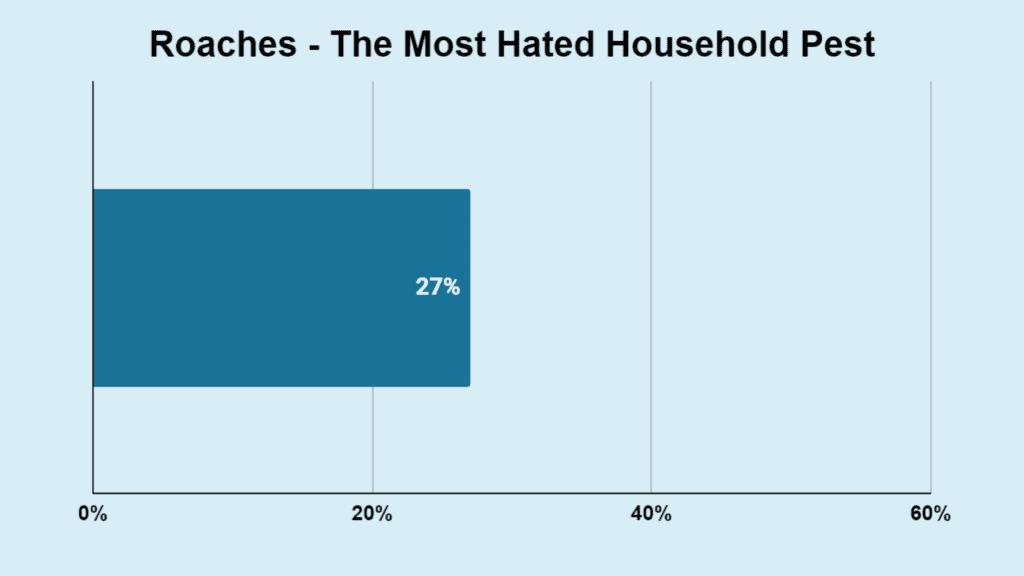
Source: Zoecon, Lake Norman Pest Control
Popular DIY Home Pest Management
Essential oils repel over 20 invaders, with mosquitoes and ants topping the list. Garlic-based pesticides control mites and fruit flies, while banana peels deter ants, roaches, and more.
Baking soda, dish soap, and salt are go-to remedies for fleas. Notably, DIY spider-repellent sprays have surged in popularity, with a 25% increase in usage over the past three years.
- Essential oils have been proven to repel over 20 types of pests. The top five critters repelled by essential oils are mosquitoes, ants, spiders, flies, and roaches.
- Garlic-based homemade pesticides can limit or eradicate mites on tomatoes and fruit flies on crops.
- Banana peels deter over 10 types of pests, including ants, roaches, aphids, caterpillars, and slugs.
- Baking soda, dish soap, and salt are the top 3 household remedies for fleas.
- DIY spider-repellent sprays have seen a 25% increase in usage over the past three years.
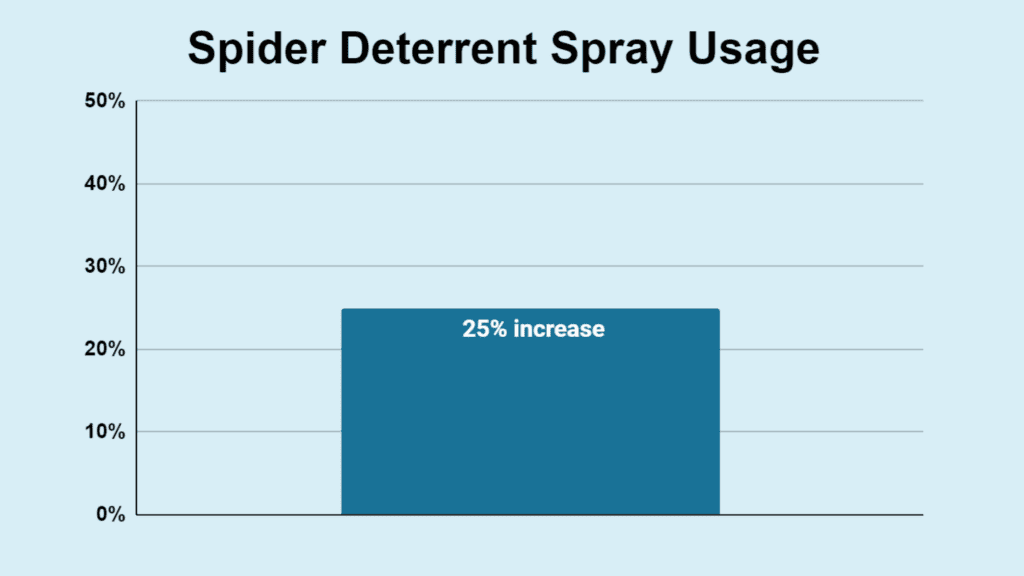
- Using coffee grounds as a creepy crawlie repellent has been adopted by 15% of city dwellers in the past year.
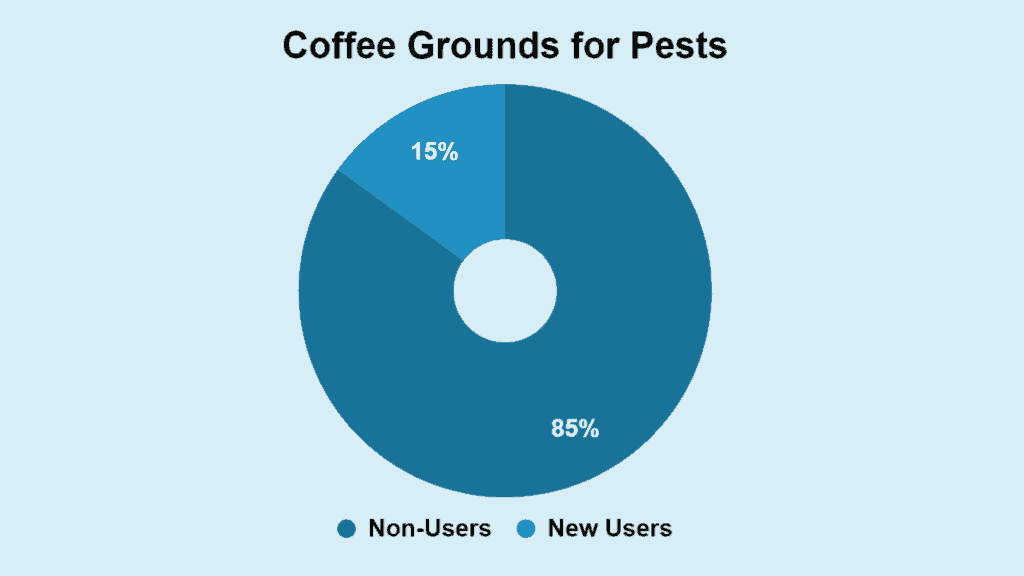
Sources: Your Green Team, Family Handyman
DIY Pest Deterrent Stats
Many homeowners take bug problems into their own hands, as evidenced by the 12,100 monthly online searches for DIY pest control solutions. Furthermore, 66% of users opt for over-the-counter remedies to tackle these issues, highlighting a clear preference for self-managed insect elimination methods.
- 37% of homeowners attempt to resolve bug issues themselves.
- There are 12,100 online searches each month for DIY pest control.
- 66% of users purchase over-the-counter critter control remedies.
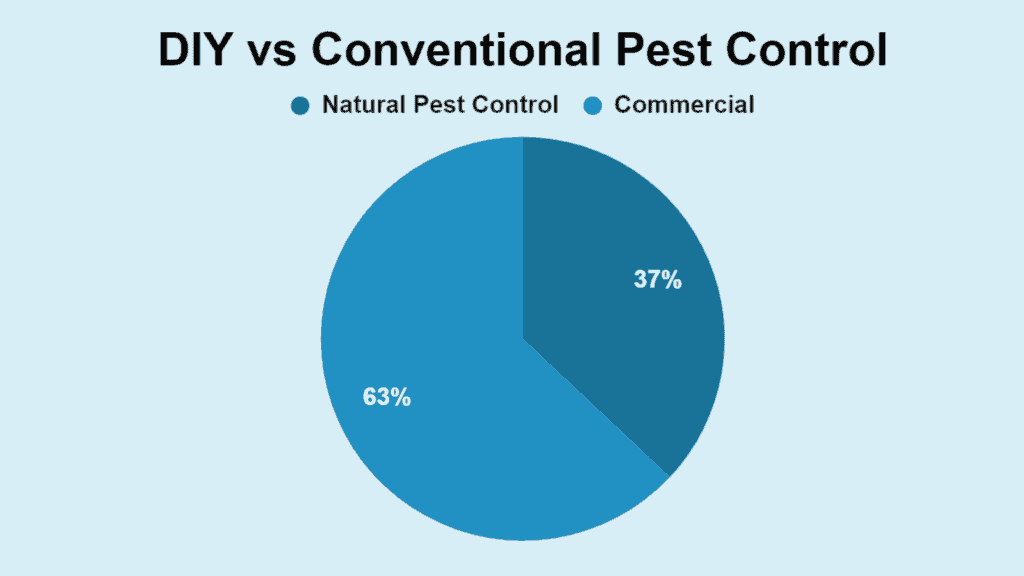
Sources: HomeTeam Pest Defense, PCT Online, Keyword Tool
DIY Pest Control Market Growth
The DIY pest control products market is on a significant growth trajectory, showcasing an impressive compound annual growth rate (CAGR). This upward trend is expected to continue, with substantial market expansion anticipated between 2023 and 2031, reflecting the increasing popularity and demand for DIY insect management solutions worldwide.
- The global DIY extermination products market is projected to reach multimillion figures by 2030.
- This market is anticipated to rise considerably between 2023 and 2031.
Demographics
Those who live in urban areas, parents, pet owners, and people aged 25-45 are leading the charge in using organic pest repellents, seeking safer alternatives to traditional pesticides.
In the U.S., residents of the South and West are more likely to embrace DIY pest control methods than their Northern and Eastern counterparts. Interestingly, using a DIY bug deterrent is more prevalent among men, with 70% engaging in these methods, compared to 30% of women.
This trend highlights a growing awareness and preference for more natural and self-managed pest control solutions across diverse demographics.
- Those in urban areas are more likely to use organic pest repellents than rural residents.
- People with children and pets are more inclined to use organic pest repellents to avoid the harmful effects of traditional pesticides.
- The use of organic pest deterrents is most popular among people aged 25-45.
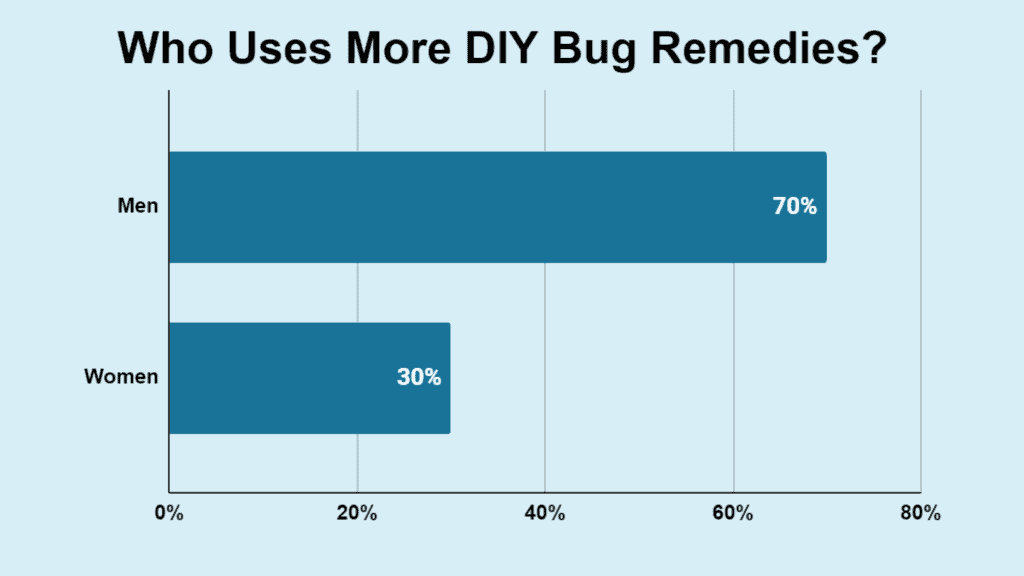
| % Do-It-Yourself Insect Strategies | |
|---|---|
| Female | 30% |
| Male | 70% |
- The Southern and Western parts of the United States are more likely to use DIY pest control methods compared to the North and East.
- Men are more likely to use DIY pest control than women, with 70% of men and 30% of women engaging in this type of treatment.
| Age Group | Popularity of Organic Products |
|---|---|
| Under 25 | Low |
| 25-45 | High |
| 46 and up | Moderate |
Cost-Effectiveness
Opting for household products as organic pest repellents is not only a cost-effective solution but also an environmentally friendly alternative to traditional pesticides.
On average, creating a DIY organic pest-repellent spray costs about $5, significantly less than the $20 or more one might spend on conventional insecticides.
Choosing organic options contributes to reducing the prevalence of dangerous chemicals that can have detrimental effects on our environment.
- Using household items as organic bug repellents is more cost-effective than purchasing traditional pesticides.
- The average cost of making a DIY organic insect-repellent spray is approximately $5, while traditional chemical treatments can cost upwards of $20.
- Organic bug repellents are also eco-friendly, reducing the need for harmful substances that can pollute the environment.
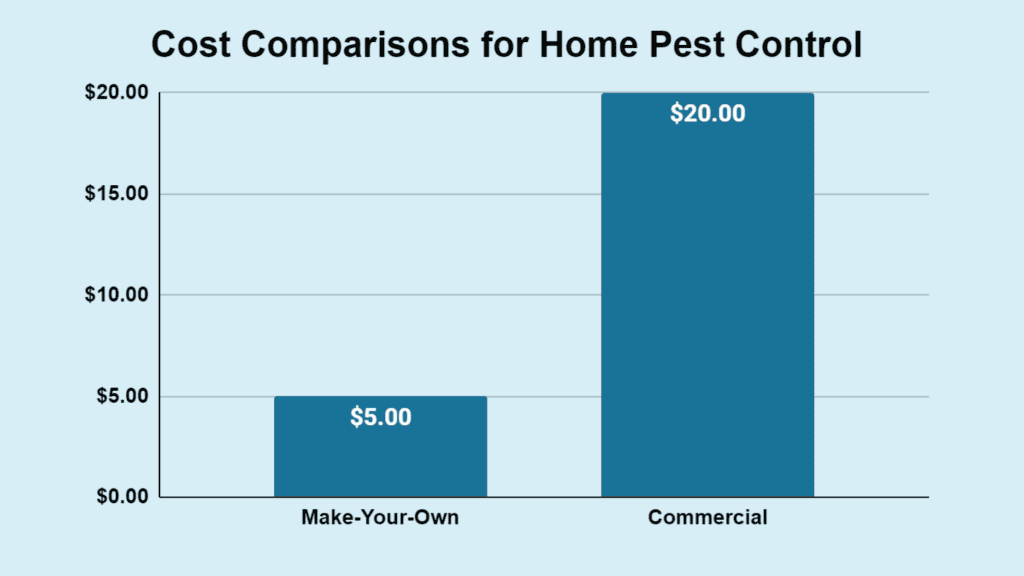
| Type of Bug Repellent | Cost |
|---|---|
| Do-It-Yourself | $5.00 |
| Conventional | $20.00 |
Cautions
- While organic pest repellents are generally safe, it is essential to use them correctly to avoid any adverse effects.
- Some people may be allergic to certain essential oils or other natural ingredients used in organic pest repellents.
- Keep all pest-repellent sprays away from children and pets.
Conclusion
Using everyday items as organic bug repellents is an inexpensive, eco-friendly, and safe alternative to traditional pest control. With a variety of items to choose from, individuals can easily find a solution that works for their specific problem.
However, it is important to use these repellents correctly and be aware of any potential allergies or adverse effects. The growth in the DIY pest management market is a testament to the increasing popularity of natural pest repellents, and this trend is expected to continue in the coming years.
Additional Research
The rise in using everyday household items as organic pest repellents is part of a more significant trend toward more sustainable and cost-effective solutions in our daily lives. This approach not only benefits the environment but also our wallets. For example, switching to natural cleaners can lead to significant savings.
Additionally, understanding the demographics of homeownership in the U.S. can provide insights into how these trends are being adopted across different segments of the population. These practices reflect a growing interest in sustainable, healthy, and financially prudent living choices.